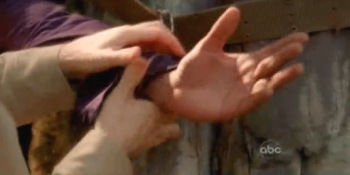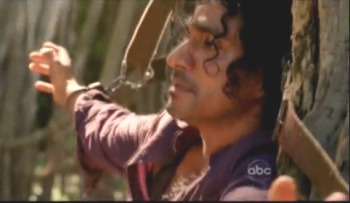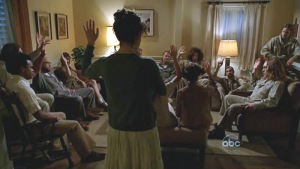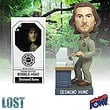The first several minutes of the Season 5 Finale, The Incident, were amazing. So many exciting things happened in such a short time — we saw Jacob for the very first time, we saw the Black Rock sailing off in the distance, we heard some puzzling dialogue, and we finally got a glimpse of all of the four-toed statue — all in the first three-and-a-half minutes.
Now, looking back, we can see that those short minutes were tightly packed with clues, hints, symbols, partial answers, and new questions.
I’m going to go back and look more closely at the opening sequence. I want to break it down and look at different aspects in different posts. So it will take longer than just today. But there’s no hurry, right? We have all the time in the world — eight long months (sigh).
Here’s the opening:
Jacob is weaving a tapestry in a room, with a fireplace in the center, that we now know is in the base of the statue. He goes out to the beach, cooks a fish (now we’ve seen fire inside and fire outside), and spots a ship which is too small, at this point, to see clearly.
He is joined by another man. They greet each other. “Morning.” “Morning.” They seem friendly, casual, polite, and evidently quite used to each other, as if this greeting were a part of their daily routines, like co-workers who greet each other every morning when they arrive at the office.
More small talk follows, and now we can see the ship, which has come closer. It’s an old-style sailing ship, most likely the Black Rock, and this is the first definite clue we’ve had that we are now centuries in the past.
And yet, something doesn’t seem right about the time period. There is something about the two men that seems like they belong in the 21st century, not hundreds of years in the past. Maybe it’s their hair styles and the way that they speak. That greeting they just exchanged — “Morning” — seems so casual and contemporary.
Now the dialogue, previously so full of comfortable small talk, gets weird:
Black shirt: How did they find the Island?
White shirt: You have to ask them when they get here.
Black shirt: I don’t have to ask. You brought them here. Still trying to prove me wrong, aren’t you?
White shirt: You are wrong.
Black shirt: Am I? They come. Fight. They destroy. They corrupt. It always ends the same.
White shirt: It only ends once. Anything that happens before that is just progress.
To paraphrase Bill Clinton, maybe the meaning of this depends on what “it” is. It always ends the same. It only ends once. What is it? Outsiders coming to the Island? What is the progress — what are they moving from and what are they moving to?
Now the dialogue gets even weirder … which means it is very weird indeed:
Black shirt (in a casual tone, as if he were talking about what he wants to have for lunch): Do you have any idea how badly I want to kill you?
White shirt (as if he were saying that he does want anchovies on their pizza): Yes
Black shirt (as if saying the pizza place might be crowded): One of these days, sooner or later, I’m going to find a loophole, my friend.
White shirt: (as if asking Black shirt to save him a seat): Well when you do, I’ll be right here.
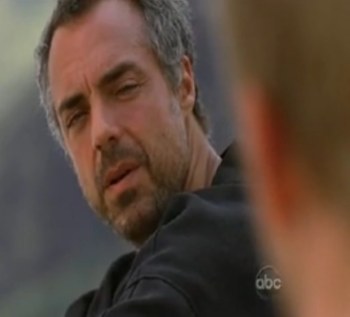
Do you have any idea how badly I want to kill you?
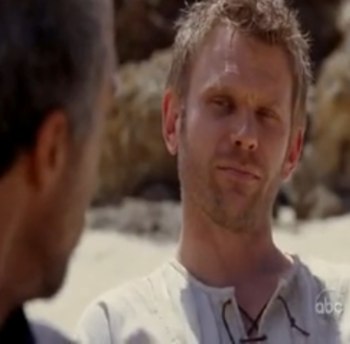
Yes.
And then before we can make any sense of that:
Black shirt: Always nice talking to you, Jacob.
Boing!
Then the camera pans up the statue.
Boing! Boing! Boing!
The pacing of this scene is very interesting. It starts off slowly with the scenes of Jacob weaving and with leisurely shots of him preparing the fish. Then there is that one-two punch at the end, which comes so quickly after the mysterious dialogue that there is no time to even begin to process the dialogue on first viewing.
Black Shirt, who appears only in this opening scene, is never named. While he says, “Always nice talking to you, Jacob,” Jacob simply replies, “Nice talking to you too.”
Around the internet, people have dubbed Black Shirt “Esau,” a clever reference to the Biblical story of the twin brothers. From here on, I will do the same.
So who or what are Jacob and Esau? What kind of beings are they who act so friendly and polite to each other, yet seem to take it for granted that one wants to kill the other?
Is it possible to come up with any theories, or will we just have to wait until Season 6 for more clues?

